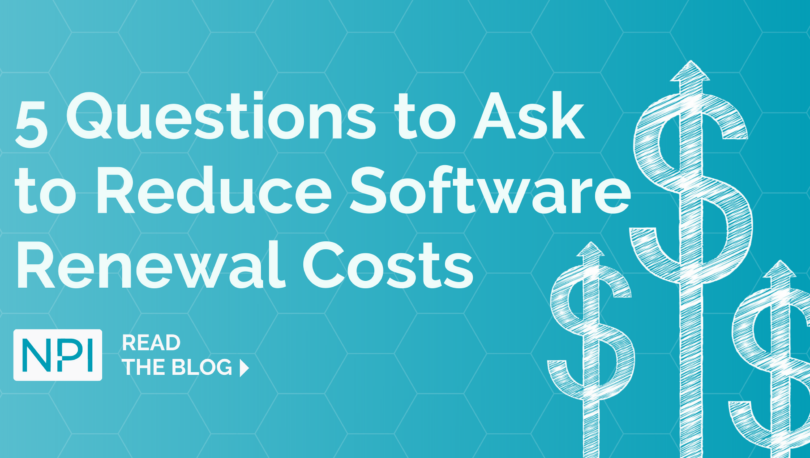As enterprise software costs spike, many IT procurement organizations are feeling new pressure from executive stakeholders to reassess and rein in spend. This is especially true for organizations that are also balancing transformation priorities. We’re frequently asked questions like: Where can we reduce IT spend without affecting “X” initiatives? How can we spend less without causing business or technical disruption? Are IT cost-cutting initiatives worth it in the long run?
The truth is not all IT cost-cutting initiatives deliver a material impact on spend. Some are disruptive and counterproductive to strategic business objectives. And many take years to execute, which diminishes the perception of effectiveness.
One tactic that can deliver immediate, significant cost impact without being disruptive is software renewal optimization – particularly for large software deployments (think Microsoft, Salesforce, Adobe, SAP, Oracle, ServiceNow, Workday, etc.). If approached with the right degree of curiosity and inspection, these events can deliver 7- and 8-figure savings. Here is a list of 5 questions to help you achieve material savings on your next large software renewal
1. Before you renew, what’s being used, unused or underutilized in your current environment?
Software overbuying and underutilization are two of the biggest threats to your enterprise IT budget. They account for an estimated 30% of software fees (particularly SaaS) and can be attributed to causes like dormant licenses, unused features, and purchasing higher-level licenses than necessary. NPI has seen scenarios where no-pulse users – printers, conference rooms, etc. – consumed tens of thousands of dollars in licensing and support fees each year. If you haven’t taken a fresh look at renewal demand definition, you’re effectively renewing on autopilot. Conduct a license optimization assessment in advance of your large software renewal to identify material savings as well as opportunities to liberate inactive licenses for redeployment.
2. If your vendor is increasing prices, how does the quote compare to peer purchases in the market?
The Wall Street Journal recently reported that business software price hikes are outpacing the rate of inflation. Corporate technology chiefs are regularly seeing price hikes of 20% to 30% (or more). One of the most effective ways to push back on software price increases is to perform IT price benchmark analysis on renewal pricing. This exercise will reveal how the vendor’s pricing compares to similarly scoped deals in the marketplace and identify any inconsistencies. Armed with this pricing intel, your IT buying team has more leverage to ensure you pay equal to or better than best-in-market pricing.
3. Does your software renewal contract include best-in-class business terms?
Pricing is just one cost lever in a software renewal negotiation. Cost-related business terms are another. Unfortunately, they don’t always get the attention they deserve in the negotiation process – and that’s a huge mistake, especially right now. Most companies and industries are undergoing significant change and transformation, in addition to navigating economic volatility. It’s more important than ever to determine where you can negotiate greater flexibility to ensure your agreement meets changing business and technical requirements over the term of your agreement.
4. What is your software license audit risk?
The frequency of software license audits has risen sharply over the last two years as vendors look to protect revenues and migrate customers to newer offerings. Companies that have a large renewal on the horizon – especially with mega-vendors like Microsoft, Oracle, SAP, Adobe, IBM, etc. – are prime targets. If caught unprepared, organizations can be slapped with 7- and 8-figure penalty fees (in addition to being forced to migrate to new offerings before they’re ready). NPI advises customers to perform a license position assessment before any major software renewal event with an audit-oriented vendor. This will help you spot and remediate compliance issues before the vendor becomes involved.
5. Do you have a competitive beachhead that you can leverage?
Many software vendors take assurance in the fact that it can be disruptively costly and tedious for customers to switch to the competition. But that confidence is shifting as customers encounter historical price increases, a changing competitive landscape, and new business and technical requirements. In the next four years, 30% of IT buyers will seek out other vendors at renewal time compared to less than 5% today. Whether you are legitimately looking to switch vendors, or simply want to apply competitive pressure, it’s important to bring viable competitive solutions to the negotiation table. One of the best places to start is leveraging competitors you’re already doing business with – most large enterprises have overlap that can be used to their advantage. Here’s another tip: Establish a renewal calendar and proactively identify upcoming opportunities to create a competitive threat. It requires advance planning – it’s not a tactic that you can deploy in the final hours of negotiation.
Do you have a large software renewal on the horizon? NPI can help you reduce costs and improve negotiation outcomes. Contact us today.
RELATED CONTENT
- Blog: Advice From the Experts: Enterprise Software Cost and License Optimization Must-Do’s
- Bulletin: Four Types of IT Sourcing Intel to Strengthen the Outcome of Negotiation with Vendors
- Bulletin: 10 Reasons Why IT Buyers Should Perform Price Benchmark Analysis
- NPI Service: IT Price Benchmark Analysis & Contract Negotiation Intel
- NPI Service: Enterprise Software License Optimization Consulting
